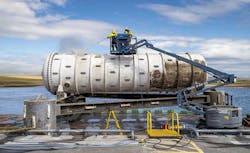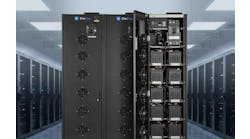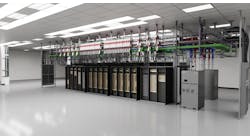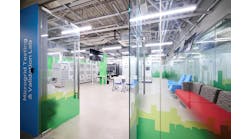Servers housed for two years on the ocean floor were substantially more reliable than those in traditional data centers, Microsoft said today, a finding that suggests that its Project Natick underwater data centers could offer surprising benefits in data center economics.
“Our failure rate in the water is one-eighth of what we see on land,” Microsoft project manager Ben Cutler said in an update. “I have an economic model that says if I lose so many servers per unit of time, I’m at least at parity with land. We are considerably better than that.”
Microsoft recently retrieved the Project Natick data center module, a 40-foot container that houses 864 servers in 12 racks that spent two years on a seabed 117 feet below the ocean’s surface off the coast of the Orkney Islands in Scotland.
The reliability data offers an intriguing new wrinkle on Microsoft’s project, suggesting the potential for longer server lifespans that could bring benefits to computing projects on land, as well as offsetting the cost of deploying in an underwater module.
The Microsoft team hypothesizes that the use of a nitrogen atmosphere, which is less corrosive than oxygen, and the absence of people to bump and jostle components, are the primary reasons for the difference. “If the analysis proves this correct, the team may be able to translate the findings to land data centers,” Microsoft noted.
The findings could guide future designs for server deployments where a nitrogen environment could be used, such as unstaffed edge data centers or facilities using robotics to manage IT equipment.
Strange New Frontiers in Data Center Deployment
For those just joining this unusual story, Project Natick represents a radical new approach to deploying data center capacity, which could enable Microsoft to shift its factory-built modular designs from earth to sea. It ties together three data center trends we’ve been tracking here at Data Center Frontier – water-based facilities, the emergence of edge computing and unmanned data centers.
When Microsoft deployed its initial Project Natick module in 2015 off the coast of California, many in the data center industry dismissed it as a science experiment – an impressive accomplishment, but not a candidate for production workloads at scale. The 2018 deployment in Scotland demonstrated that Microsoft is serious about investigating the potential for deploying underwater data centers as part of its strategy for edge computing, bringing cloud capacity closer to population centers concentrated along coastlines around the world.
The Orkney module adapted a heat-exchange process commonly used for cooling submarines, piping seawater directly through the radiators on the back of each of the 12 server racks and back out into the ocean.
The chamber was filled with nitrogen, and after the module was lifted from the ocean, the Microsoft researchers inserted test tubes through a valve at the top of the vessel to collect air samples for analysis. One of the questions is whether gases that are normally released from cables and other equipment may have altered the operating environment for the computers.
The cleaned and air-sampled datacenter was loaded onto a truck and driven to Global Energy Group’s Nigg Energy Park facility in the North of Scotland. There, Naval Group unbolted the endcap and slid out the server racks as the Microsoft team performed health checks and collected components to send to the company’s headquarters in Redmond, Washington for further analysis.
Team members from Microsoft inspect servers inside the Project Natick undersea server module at Nigg Energy Park in Inverness, Scotland. (Photo: Microsoft)
Among the components crated up and sent to Redmond are a handful of failed servers and related cables. The researchers think this hardware will help them understand why the servers in the underwater data center are more reliable than those on land.
“We are now at the point of trying to harness what we have done as opposed to feeling the need to go and prove out some more,” Cutler said. “We have done what we need to do. Natick is a key building block for the company to use if it is appropriate.”
Whether or not the research supports deploying servers underwater, the Natick findings offer new possibilities for designing unstaffed “lights out” data centers.
“We are populating the globe with edge devices, large and small,” said William Chappell, vice president of mission systems for Azure. “To learn how to make datacenters reliable enough not to need human touch is a dream of ours.”






